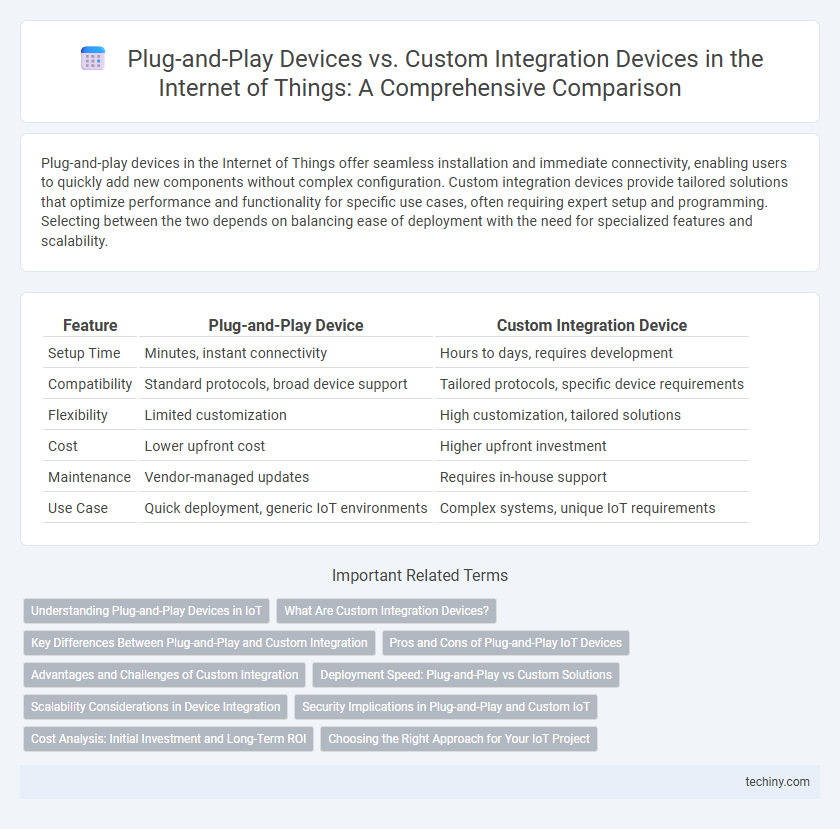Plug-and-play devices in the Internet of Things offer seamless installation and immediate connectivity, enabling users to quickly add new components without complex configuration. Custom integration devices provide tailored solutions that optimize performance and functionality for specific use cases, often requiring expert setup and programming. Selecting between the two depends on balancing ease of deployment with the need for specialized features and scalability.
Table of Comparison
| Feature | Plug-and-Play Device | Custom Integration Device |
|---|---|---|
| Setup Time | Minutes, instant connectivity | Hours to days, requires development |
| Compatibility | Standard protocols, broad device support | Tailored protocols, specific device requirements |
| Flexibility | Limited customization | High customization, tailored solutions |
| Cost | Lower upfront cost | Higher upfront investment |
| Maintenance | Vendor-managed updates | Requires in-house support |
| Use Case | Quick deployment, generic IoT environments | Complex systems, unique IoT requirements |
Understanding Plug-and-Play Devices in IoT
Plug-and-play devices in IoT simplify deployment by automatically connecting and configuring with existing networks and systems, reducing setup time and technical expertise. These devices typically adhere to standardized communication protocols such as MQTT, Zigbee, or Bluetooth Low Energy, ensuring seamless interoperability across diverse platforms. Their ease of integration accelerates the adoption of IoT solutions in smart homes, industrial automation, and healthcare monitoring.
What Are Custom Integration Devices?
Custom integration devices in the Internet of Things (IoT) are specifically designed and programmed to meet unique application requirements, enabling seamless connectivity and specialized functionality within complex systems. Unlike plug-and-play devices, these are tailored to interact with various protocols, sensors, and platforms, providing enhanced flexibility and scalability for industrial automation, smart cities, and healthcare environments. Their bespoke nature allows for optimized performance and secure data exchange tailored to the distinct operational needs of each IoT deployment.
Key Differences Between Plug-and-Play and Custom Integration
Plug-and-play IoT devices offer standardized interfaces and immediate usability, enabling quick deployment without extensive configuration, while custom integration devices require tailored development for specific applications, ensuring optimized performance and flexibility. Plug-and-play solutions prioritize ease of use and scalability across diverse environments, whereas custom integration emphasizes deep system compatibility and bespoke functionality tailored to unique operational requirements. Key differences lie in deployment time, customization level, and adaptability to evolving IoT ecosystems.
Pros and Cons of Plug-and-Play IoT Devices
Plug-and-play IoT devices offer simplified installation and seamless connectivity by automatically configuring themselves within existing networks, reducing deployment time and technical expertise requirements. However, their limited customization options and potential security vulnerabilities pose challenges for specialized applications and environments demanding stringent data protection. Despite these drawbacks, plug-and-play solutions enhance scalability and interoperability, making them ideal for standard smart home or office setups.
Advantages and Challenges of Custom Integration
Custom integration devices in the Internet of Things offer tailored functionality, enabling seamless operation within complex systems and providing enhanced security measures compared to generic plug-and-play devices. These devices require specialized development and increased initial costs, posing challenges such as longer deployment times and the need for expert technical knowledge. Despite these hurdles, custom integration ensures optimized performance and scalability tailored to specific enterprise requirements.
Deployment Speed: Plug-and-Play vs Custom Solutions
Plug-and-play devices drastically reduce deployment time by offering pre-configured, standardized connectivity that requires minimal setup, enabling rapid integration in IoT ecosystems. Custom integration devices demand extensive development, testing, and configuration, significantly extending deployment timelines due to tailored hardware and software requirements. Prioritizing plug-and-play solutions accelerates time-to-market, while custom integrations provide flexibility at the cost of slower rollouts.
Scalability Considerations in Device Integration
Plug-and-play devices offer seamless scalability by enabling quick addition and replacement without extensive reconfiguration, ideal for rapidly growing IoT ecosystems. Custom integration devices require tailored development and testing, which may limit scalability due to longer deployment timelines and higher resource demands. Organizations prioritizing scalability often favor plug-and-play solutions to maintain flexible, adaptive IoT networks that can efficiently handle increasing device volumes.
Security Implications in Plug-and-Play and Custom IoT
Plug-and-play IoT devices often present significant security risks due to standardized protocols and default settings that can be exploited by attackers. Custom integration devices allow for tailored security measures, including encryption and access controls specific to organizational needs, reducing vulnerability. However, custom solutions require ongoing management and expertise to maintain security effectiveness over time.
Cost Analysis: Initial Investment and Long-Term ROI
Plug-and-play IoT devices typically require a lower initial investment due to standardized hardware and minimal setup costs, enabling faster deployment and reduced labor expenses. Custom integration devices often involve higher upfront costs from tailored hardware development and complex system configuration but can yield superior long-term ROI by aligning closely with specific business needs and improving operational efficiencies. Evaluating total cost of ownership, including maintenance and scalability, is crucial for determining the most cost-effective solution in IoT implementations.
Choosing the Right Approach for Your IoT Project
Choosing the right approach for your IoT project depends on factors such as scalability, budget, and technical expertise. Plug-and-play devices offer quick deployment and ease of use with standardized protocols, making them ideal for small-scale or commercial applications. Custom integration devices provide tailored solutions with enhanced functionality and flexibility, suitable for complex projects requiring specific performance and data management.
Plug-and-Play Device vs Custom Integration Device Infographic

 techiny.com
techiny.com